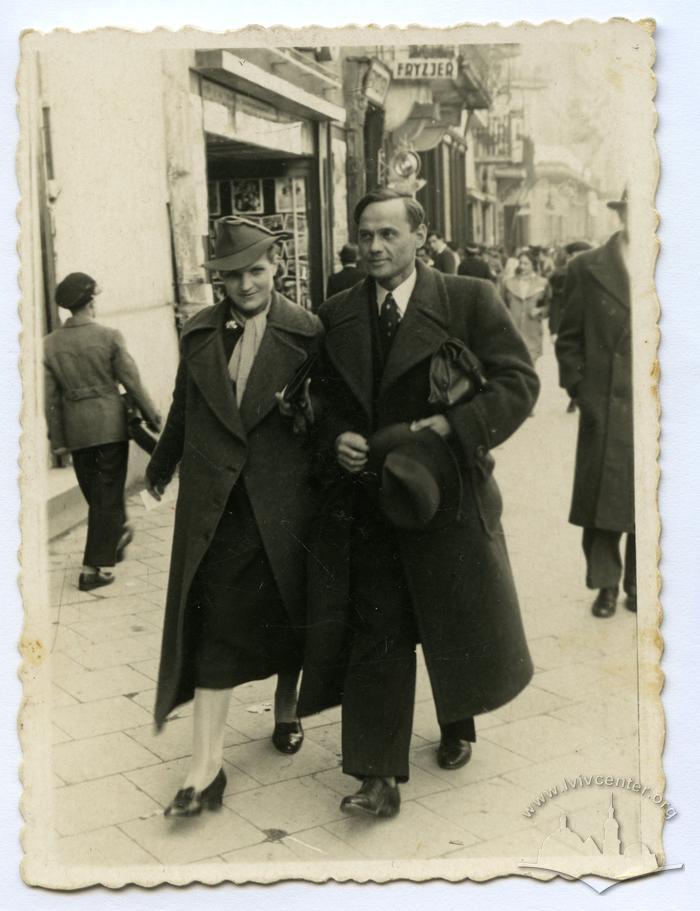
- Title:
Olha Maria Zhydacek and her husband Hryhoriy Bandurka, Lviv, spring 1939
- Author:
- Year:
- 1939
- See more:
- Urban Media Archive
- Collection:
- Bozhena Pelenska
Worked on the material:
- Research, comment
Anastasia Kholyavka
- Editing
Bohdan Shumylovych
- Translation into English
Svitlana Bregman
- Photo
Bozhena Pelenska’ collection in Urban Media Archive
Comments and discussions

This photo is a testimony to a photographic practice popular in the 1930s. It was about making portraits of passers-by on the city streets. Such photos often recorded people in motion in the middle of a large street, and seemed to emphasize the belonging of those depicted characters to urban culture. In view of this, the genre of such photography can be called street portrait, the street and commercial photography. The photo shows the great-grandmother and great-grandfather of Bozhena Pelenska — Olha-Maria Zhydacek and her husband Hryhoriy Bandurka (b. 1899). Based on the Bozhena’s memories, the story was recorded of the photograph and of the people in it.
The photo was taken on the eve of World War II, before the events that changed the life of this family, like for many others in Lviv. On the back, the photo has an inscription in Ukrainian: “Spring, 1939.” The number 2 is also written in pencil, which may indicate that there were two such photos. The time of creation can also be implied by the clothes of the people in the photo, and the ornamented edges common for the 1930s. The photographs’ surface is scratched. It indicates the storage in a stack with other photographs rubbing against each other with the edges. There is no information about whether the photo traveled with the owners to the exile, or if it was kept by relatives in Lviv. However, it was an essential source of family memory.
The photo was printed on half a sheet for printing postcards produced by Fabryka Płyt i Papierów Fotograficznych “ALFA”, Bydgoszcz, as evidenced by the mark on the back. The inscription is made with a ballpoint pen. It means that it was written later, to keep information about the time of creation of the photo. Street photography implied that people would come back to pick up the photos printed by a photographer or by his assistant. Therefore, the fact that the photo stayed in the family archive of the characters means that Maria and Hryhoriy wanted to get the photo and returned to pick it up.
A young couple was photographed when walking in the city past the point where a street photographer worked. A common feature of this genre at that time was the storyline when people seemed to be randomly caught in motion in the middle of the city, in their usual environment, which emphasized their status as urban residents. The composition is also characteristic: a smiling couple walks among other people but the camera focused on them. thus, the people are in the center of the frame, and other passers-by are out of focus. The woman is watching into the camera, and the man took off his hat to reveal his face to the camera. there are illuminated facades of buildings behind, and “Fryzjer” sign, which helps identify the location in the city center of Lviv. The portal behind is surrounded by shop-windows that show the rectangles of different formats. Those can be books, postcards, posters, or photos.
Hryhoriy’s mother, Maria, was Polish, and a father Andrei’s was Ukrainian. Hryhoriy chose Ukrainian identity and graduated from the Academic Gymnasium in Lviv. Since the interwar Polish Republic created unfavorable conditions for higher education for Ukrainians, Hryhoriy graduated from the Medical University in Prague, and became a doctor. The couple lived separately from their parental families, since Hryhoriy had his own office to receive patients, and the family could be self-sufficient. From the family memories, we know that he was politically active and that he was arrested for this in 1945. After that, Olha-Maria returned to live in Znesinnia (a less urbanized area of Lviv); and in 1946 she was displaced to Siberia with her eldest daughter. Another daughter was born in exile. It was Bozhena Pelenska’s mother. Maria and Hryhoriy survived owing to medical specialty but they were banned from returning to Lviv. After de-Stalinization in the USSR, in 1956, the family was liberated and moved to the Khmelnytskyi region. Later, they unofficially moved to Zhovkva, near Lviv, and lived there with their family. Later, Hryhoriy Bandurka managed to reclaim his usual profession, and as a highly qualified doctor, he chaired a TB hospital in Lviv. But the traumatic experience of Soviet repressions has forever stayed in the family, and photographs helped to keep that memory.
See more on making portraits of passers-by on the city streets in: Ірина Котлобулатова, Єврейські фотографи та фотостудії Львова (1860-1939), Львів: Видавництво Старого Лева, 2023.